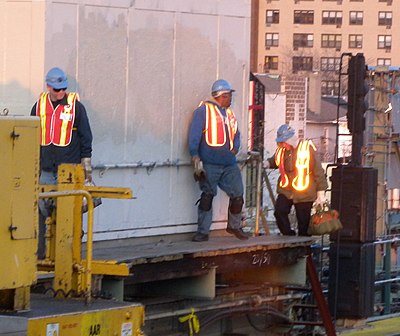
Search
Construction worker

A construction worker is a worker employed in the physical construction of the built environment and its infrastructure.
Definition
By some definitions, construction workers may be engaged in manual labour as unskilled or semi-skilled workers. These workers begin by attending to general tasks such as digging, cleaning, and unloading equipment. As they acquire experience, they start to specialize in areas of roofing, pipefitting, structural work, or carpentry. Over time, some opt to receive certification and undergo formal training to ascend their position. In other words, they may be skilled tradespeople, or they may be supervisory or managerial personnel.
Conversely, the United Kingdom safety legislation has defined construction workers as people "who work for or under the control of a contractor on a construction site." In Canada, this can include people whose work includes ensuring conformance with building codes and regulations and those who supervise other workers. Construction workers can colloquially be referred to as "hard hat workers" or "hard hats", as they often wear hard hats for safety while working on construction sites.
Nevertheless, the term is a broad and generic one and most construction workers are primarily described by the specific level and type of work they perform. Laborers comprise a large grouping in most national construction industries. In the United States, for example, in May 2021, the construction sector employed just over 7.5 million people, of whom just over 820,000 were laborers, while 573,000 were carpenters, 508,000 were electricians, 258,000 were equipment operators and 230,000 were construction managers. Like most business sectors, there is also substantial white-collar employment in construction - 681,000 US workers were recorded by the United States Department of Labor as in 'office and administrative support occupations' in May 2021. In 2023, the United States reported that, of the total number of construction workers, 27.7% of workers were Hispanic and around 6.2% were women.
Safety
The construction industry is a high-hazard sector, encompassing alteration and repair. Workers are exposed to various serious hazards, such as falling debris, unguarded machinery, heavy equipment, electrocutions, silica dust, and asbestos. Thus, construction safety is intended to ensure a safe environment for workers, who are required to be educated on safety at each site. Construction workers must remain vigilant by keeping work areas clear, learning safe lifting techniques, being aware of seasonal hazards, and regularly inspecting all equipment, among other preventive measures.
Examples of poor pay and working conditions for migrant workers
In 2008, a Human Rights Watch report described unsafe and unfair working conditions in China and a failure on the part of the government to enforce labor standards in the construction industry. The International Labour Organization (ILO) estimated that, at the end of 2006, 90% of the 40 million construction workers in China were migrant workers. Many turned to work after their farming communities collapsed into poverty.
In the United States, illegal immigrant labor is prevalent in the industry. Due to workers' questionable legal status, some employers commit crimes such as wage theft and violation of workplace standards, running little risk of consequences. Similar abuse occurred in Qatar during preparations for the 2022 FIFA World Cup where workers, mostly from poor countries in the Indian subcontinent, worked in desert conditions for as little as €6.20 a day.
See also
References
External links
- Construction and Maintenance at Curlie
Text submitted to CC-BY-SA license. Source: Construction worker by Wikipedia (Historical)
Owlapps.net - since 2012 - Les chouettes applications du hibou


